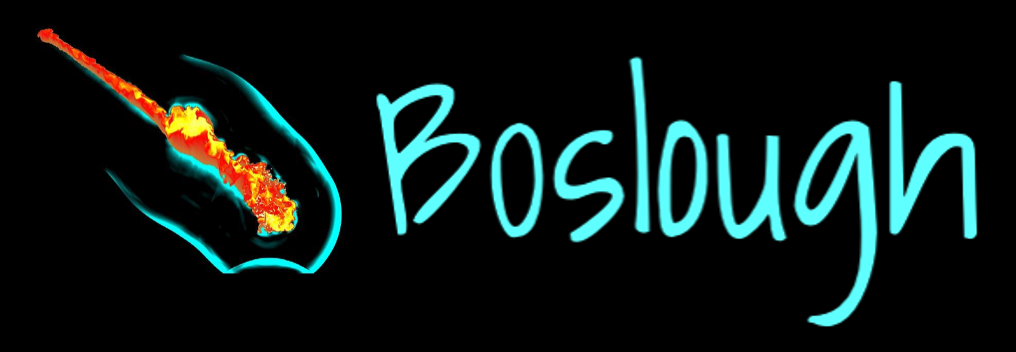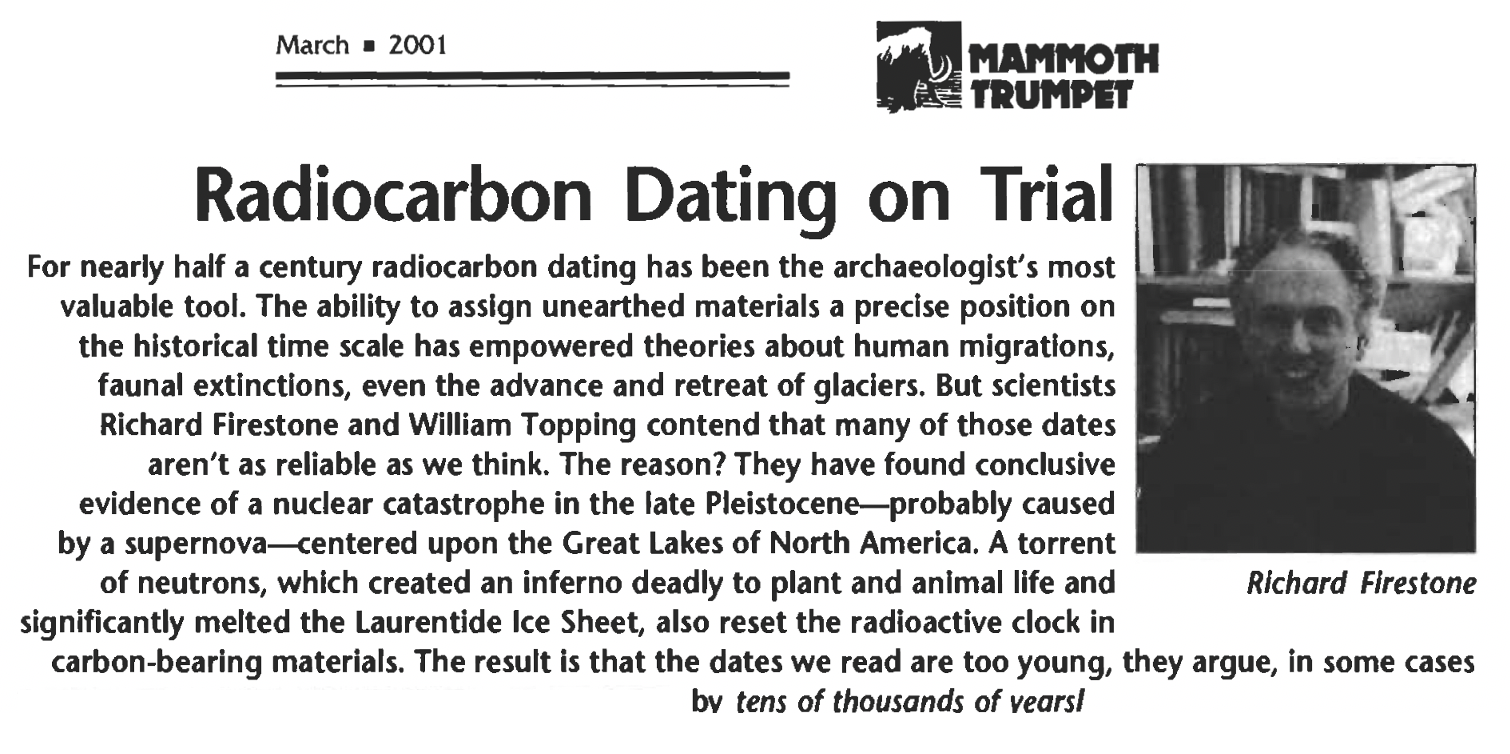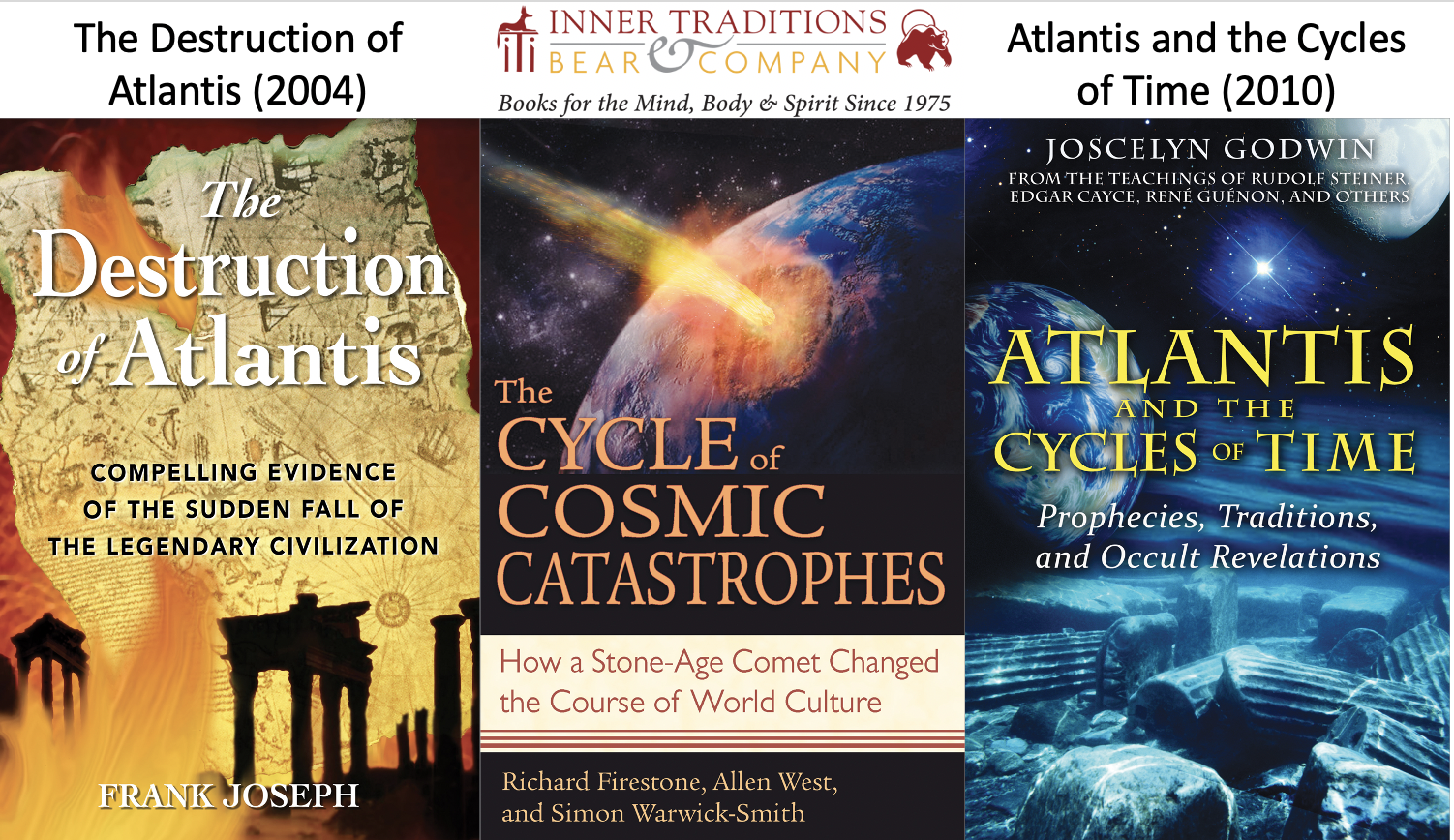The Fringe Roots of the Younger Dryas Impact Hypothesis: Part 1
Fifteen years ago, devotees of a fringe theory attempted to rebrand it as science. On October 9, 2007, a would-be paradigm-changing paper was published. Plagued by self contradictions, logical fallacies, basic misunderstandings, misidentified impact evidence, abandoned claims, irreproducible results, questionable protocols, lack of disclosure, secretiveness, failed predictions, contaminated samples, pseudoscientific arguments, physically impossible mechanisms, misrepresentations, ad hominem attacks, and revelations of fraud, it has never been accepted by subject matter experts in any related field. The long-lasting and overwhelming rejection by mainstream scientists has only increased its pseudoscientific appeal, and advocates are again marketing it to pseudoarchaeology buffs and fans of other fringe theories.
Firestone et al (2007), “Evidence for an extraterrestrial impact 12,900 years ago that contributed to the megafaunal extinctions and the Younger Dryas cooling”, the paper that introduced the Younger Dryas Impact Hypothesis (YDIH), was published on October 9, 2007. I first learned this idea earlier that year from an email chain that was forwarded to me by a colleague with the article “Blast in the Past?” attached. It had been started by an archaeologist I didn’t know. It had found its way to me, because I had spent the previous year talking about the evidence for airbursts in the geological record, including the Libyan Desert Glass. My models had recently been featured in the documentary Tutankhamen’s Fireball. I had just attended the 2007 Planetary Defense Conference (PDC) where I had presented some of the first computational models of airbursts, like the 1908 Tunguska event, using new methods I had developed for my Libyan Desert Glass simulations. In my PDC abstract I had argued that “The most likely scenario for a costly or fatal impact event is not a crater-forming collision, but a large aerial burst.” The archeologists and quaternary geologists on the email chain were skeptical, and I agreed. I wrote, “…a 5-km diameter asteroid would NOT explode in the atmosphere, no matter what properties it had. I'm surprised Nature would even repeat this suggestion.” I would later learn that the idea, now known as the “Younger Dryas Impact Hypothesis”, didn’t just violate the laws of physics. It neglected a vast body of research and dismissed the foundational principles of many other disciplines, including archeology, geology, paleoecology, geochronology, paleontology, and paleoclimatology. It had its roots in fringe science.
The Younger Dryas Impact Hypothesis (YDIH) was introduced by Richard Firestone and 25 coauthors on October 9, 2007. It was based on a fringe idea he had published in a newsletter with coauthor William Topping in 2001.
Fringe Roots
The Firestone version of the YDIH has its origins in the March, 2001 issue of the Mammoth Trumpet, the quarterly newsletter of the Center for the Study of the First Americans. Firestone’s article with William Topping, “Terrestrial Evidence for a Nuclear Catastrophe in Paleoindian Times”, based on the premise that Radiocarbon dating doesn’t work, an argument that has long been made by young-Earth creationists. But whereas creationists argue that old ages are wrong because they violate their belief in the literal truth of the Bible, Firestone & Topping wanted young ages to be wrong because it violated their belief that they were looking at uncontaminated ancient sediments. The pseudoscientific logic of a Younger Dryas nuclear catastrophe is the same, but with an opposite sign.
Firestone’s idea was as potentially paradigm-shifting as scientific proof of Noah’s flood or talking snakes. If true, it would overthrow everything we thought we knew about astronomy, physics, earth science, biology, and human natural history. The Mammoth Trumpet editor saw it that way too, and published a front-page disclaimer called “Radiocarbon Dating on Trial” enumerating all the theories that have been empowered by radiocarbon dating, along with a multi-page tutorial called “Carbon and Radiocarbon Dating: a Primer.” “Firestone,” he said, “supports their theory with evidence exhaustively compiled from sea sediments, ice cores, and concentrations of radioactive isotopes. Their report marks an end of a long journey for Topping: for more than 10 years he has traveled the breadth of his native Michigan, convinced, despite radiocarbon dating to the contrary, that he was looking at features more than 40,000 years old.”
The paradigm-shifting potential was not lost on this editor, who went on to describe the absolute rethinking it would require if true.
“For nearly half a century radiocarbon dating has been and indespensable tool of archaeologists, anthropologists, paleontologists, geologists. Chronologies of human migration, fauna extinctions, even glacial movements have been based with absolute confidence on the dating of evideontiary carboniferous materials. Firestone and Topping contend that radiocarbon dates for sites in North America are suspect, the result of a late-Pleistocene cosmic ray bombardment that created vast amounts of radiocarbon and thereby re-set the clock by which radiocarbon dating measures the passage of time... Firestone and Topping’s theory challenges the chronology that underpins many theories. Consequently, it casts doubt on many theories themselves.”
The editor also emphasized the confidence with which the authors defended their belief with the fervor of true believers or creationists, even though it would admittedly disrupt and destroy the chronological underpinning of archaeology, anthropology, paleontology, and geology. Regarding their claims of abnormal depletion of 235-U and elevated levels of 239-Pu: “The only phenomenon capable of such imbalances, they argue, is massive neutron bombardment, probably from a supernova. It is inescapable, they contend, that the catastrophe, which left its signature in abnormal isotopic ratios, must also have radically increased the radiocarbon content of materials, even the subterranean deposits. They conclude that radiocarbon dates for these altered materials inevitably make the materials appear younger than they actually are.” Bold and italic emphasis is in the original.
Deeper into the Fringe
The Mammoth Tusk is an excellent newsletter that’s written for both specialists and the general public, but it is not a peer-reviewed scientific journal. One way to assess whether or not a paper stands the test of time is to see what it looks like after it’s been published in a refereed academic journal, and how many times it’s been cited. After 21 years, the nuclear catastrophe hypothesis of Firestone and Topping has never made it through peer review. According to Google Scholar, it has been cited just 31 times. Of those, 10 citations have been by prominent critics of the YDIH, and 2 were self-citations by Firestone and coauthors, but not in the peer-reviewed literature. Another self-citation that Google Scholar didn’t find was Firestone et al (2007), the subject of this article.
Firestone and Topping (2001) wasn’t cited until four years later. The first citation was by a 2005 book by Paul A. LaViolette called “Earth Under Fire: Humanity's Survival of the Ice Age”. Here are some of the descriptive phrases from the book’s promotional blurb:
“An investigation of the connection between ancient world catastrophe myths and modern scientific evidence of a galactic destruction cycle.”
“Provides scientific evidence of past Earth-wide catastrophes and their galactic superwave origins.”
“Decodes the ancient message encrypted in the zodiac constellations and symbolism of the Sphinx.”
The book’s publisher, Bear & Company/Inner Traditions, has a website that allows you to browse by subject. The top subjects on the browse list are, “Astrology, Tarot, & Divination”, “New Age”, “Shamanism & Indigenous”, “Paganism”, “Esoteric & Occult”, and “Ancient Mysteries”. If you click on “Ancient Mysteries” you get a drop-down menu with “Lost Knowledge”, “Atlantis & Forgotten Worlds”, “Egyptian Mysteries”, “The Americas”, and “Ancient Aliens”.
A search of the publisher’s website turns up other books by LaViolette that are solidly within its stated areas of interest. “Decoding messages” appears to deserve a category of its own.
Like most scientists, I would be mortified if a paradigm-changing paper I had written didn’t get cited for 4 years, and then only by a pseudoscience book by a publisher that specializes in quackery. Firestone, apparently, saw it as an opportunity. Among the other books listed on the publisher’s website is “The Cycle of Cosmic Catastrophes” by Richard Firestone, Allen West, and Simon Warwick-Smith. According to the publisher’s blurb,
“The Cycle of Cosmic Catastrophes presents new scientific evidence of a series of prehistoric cataclysmic events that not only validates the legends and myths of our ancestors’ extinctions by fire, quake, and flood, but shows how these events suggest that we are entering a thousand-year cycle of increasing danger and possibly a new cycle of natural disasters.”
I do not have a copy and have not read it, but according to David Morrison’s 2010 Skeptical Inquirer article, “Did a Cosmic Impact Kill the Mammoths?”:
“This book develops Firestone’s 2001 suggestion that a cosmic ray catastrophe, probably caused by a supernova, occurred in northeastern North America in the late Pleistocene. He concluded that massive thermal neutron irradiation radically altered the radioactivity of terrestrial materials and ‘probably figured in the mass extinction of the Ice Age fauna.’ In The Cycle of Cosmic Catstrophes, Firestone links the YD impact to this postulated nearby supernova, which he asserted took place 41,000 years ago and initially devastated most life in Asia. Then, 34,000 years ago the shock wave from this supernova initiated another wave of intense cosmic bombardment of Earth. The only evidence for this event is the remarkable claim that mastodon tusks from about that time are pitted with cosmic dust, suggesting that these animals received the direct blast of supernova material striking earth (unstopped, apparently by our atmosphere).
“In The Cycle of Cosmic Catastrophes, the debris cloud from the supernova is supposed to have reached Earth about 13,000 years ago. The YD impact was one manifestation of this blast wave, bathing the planet in radioactivity and destabilizing the magnetic field. In this book the authors suggest that the Carolina Bays were created by secondary impacts of ejecta from the main hit in the North American ice sheet. To produce this much ejecta, the hit must have been among the most catastrophic events in Earth’s history. They suggested that the YD impact excavated Hudson Bay, making it larger than the KT impact of sixty-five million years ago, which is estimated to be a once-in-one-hundred-million-years event. Yet supposedly this huge hit did not produce a worldwide mass extinction but influenced only the megafauna of North America. This entire scenario is inconsistent with what astronomers know about supernovas, which Phil Plain summarized in his recent book Death from the Skies. It raises serous questions about the reliability of the PNAS paper that Firestone and West, with two dozen additional authors, published a year later.”
“Destruction of Atlantis”, “Cycle of Cosmic Catastrophes", and “Atlantis and the Cycles of Time” were all published by Inner Traditions/Bear & Company. They are all in the publisher’s category, “Ancient Mysteries”.
Never Mind
In 2007, everything changed. In an effort to go mainstream, Firestone had to collaborate with legitimate, established scientists. He had to present his data at a scientific conference by a recognized scientific society. And he had to publish in a scholarly journal. But that meant he would have to abandon (at least temporarily) some of his most outlandish ideas. The result was Firestone et al (2007) which was published 15 years ago today.
The entire point of the paper was that supposed “impact markers” were found across North America at the Younger Dryas Boundary (YDB), which was identified in sediments using radiometric dating. The paper states, “At the sites studied, independent radiocarbon and optically stimulated luminescence dates that tend to cluster near 13 ka were used to establish the age of the YDB.” The table 1 caption, which shows those ages for 10 sites, says “Radiocarbon ages are calibrated.”
Firestone et al (2007) was the first peer-reviewed paper to cite Firestone and Topping (2001), but failed to mention its main point. Here’s the entire discussion:
In the 1990s, W. Topping (14) discovered magnetic microspherules and other possible ET evidence in sediment at the Gainey PaleoAmerican site in Michigan (see also ref. 15), and Lougheed (16) and Bi (17) reported that late Pleistocene glacial drift contained similar cosmic spherules. We now report substantial additional data from multiple, well dated stratigraphic sections across North America supporting a major ET airburst or collision near 12.9 ka.
(14) RB Firestone, W Topping Mammoth Trumpet 16, 1–5 (2001).
(15) RB Firestone, A West, S Warwick-Smith Cycle of Cosmic Catastrophes (Bear, Rochester, VT), pp. 19–35 (2006).
For the YDIH proponents, radiocarbon dates seem to depend on the hypothesis, not the other way around.
To be Continued
One of the main criticisms of Firestone et al (2007) is lack of age control. How do they know that what they’ve identified as the YDB is actually 12.9 thousand years old, especially given that the lead author doesn’t accept radiocarbon dates from the time of the catastrophe? They have yet to provide the data on which the graphs of their evidence are based. In an effort to get to the bottom of this, I have created a PubPeer page where anyone can ask questions about this (or any) issue they have with the paper. I will continue to write about problems with the YDIH, and discuss how its proponents have recently gotten back in touch with its fringe roots.




